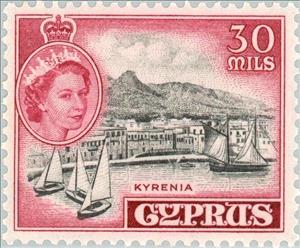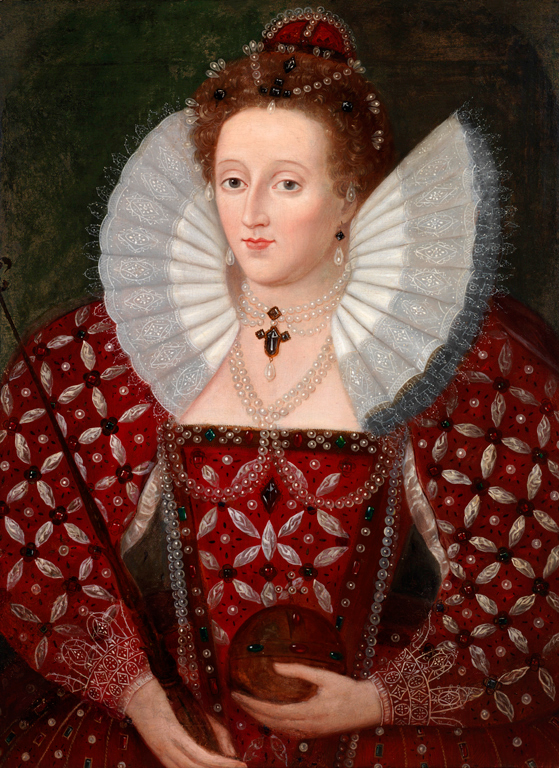Stamp: Queen Elizabeth II & Kyrenia Harbor (Cyprus 1955)
Queen Elizabeth II & Kyrenia Harbor (Cyprus 1955)
01 August (Cyprus ) within release Definitives goes into circulation Stamp Queen Elizabeth II & Kyrenia Harbor face value 30 Cypriot mil
| Stamp Queen Elizabeth II & Kyrenia Harbor in catalogues | |
|---|---|
| Michel: | Mi:CY 171 |
Stamp is horizontal format.
Also in the issue Definitives:
- Stamp - Queen Elizabeth II & Carobs face value 2;
- Stamp - Queen Elizabeth & Grapes face value 3;
- Stamp - Queen Elizabeth II & Troodos Forest face value 15;
- Stamp - Queen Elizabeth II & Hala Sultan Tekke face value 100;
- Stamp - Queen Elizabeth II & Church of Kanakaria face value 250;
- Stamp - Queen Elizabeth II & Harvest in Mesaoria face value 35;
- Stamp - Queen Elizabeth II & Famagusta Harbor face value 40;
- Stamp - Queen Elizabeth II & St. Hilarion Castle face value 50;
- Stamp - Queen Elizabeth II & Beach of Aphrodite face value 20;
- Stamp - Queen Elizabeth II & Oranges face value 5;
- Stamp - Queen Elizabeth II & Copper Pyrites Mine face value 10;
- Stamp - Queen Elizabeth II & Ancient Coin of Paphos face value 25;
- Stamp - Queen Elizabeth II & Kyrenia Harbor face value 30;
- Stamp - Queen Elizabeth II & Ancient Coins face value 500;
- Stamp - Queen Elizabeth II & Coat of Arms face value 1;
Stamp Queen Elizabeth II & Kyrenia Harbor it reflects the thematic directions:
A head of state (or chief of state) is the public persona that officially represents the national unity and legitimacy of a sovereign state. In some countries, the head of state is a ceremonial figurehead with limited or no executive power, while in others, the head of state is also the head of government. In countries with parliamentary governments, the head of state is typically a ceremonial figurehead that does not actually guide day-to-day government activities and may not be empowered to exercise any kind of secular political authority (e.g., Queen Elizabeth II as Head of the Commonwealth). In countries where the head of state is also the head of government, the president serves as both a public figurehead and the actual highest ranking political leader who oversees the executive branch (e.g., the President of the United States).
A ship is a large watercraft that travels the world's oceans and other sufficiently deep waterways, carrying passengers or goods, or in support of specialized missions, such as defense, research and fishing. Historically, a "ship" was a sailing vessel with at least three square-rigged masts and a full bowsprit. Ships are generally distinguished from boats, based on size, shape and load capacity.
A vehicle (from Latin: vehiculum) is a mobile machine that transports people or cargo. Typical vehicles include wagons, bicycles, motor vehicles (motorcycles, trucks, buses), railed vehicles (trains, trams), watercraft (ships, boats), aircraft and spacecraft. Land vehicles are classified broadly by what is used to apply steering and drive forces against the ground: wheeled, tracked, railed or skied. ISO 3833-1977 is the standard, also internationally used in legislation, for road vehicles types, terms and definitions.
A port is a maritime facility comprising one or more wharves or loading areas, where ships load and discharge cargo and passengers. Although usually situated on a sea coast or estuary, ports can also be found far inland, such as Hamburg, Manchester and Duluth; these access the sea via rivers or canals. Because of their roles as ports of entry for immigrants as well as soldiers in wartime, many port cities have experienced dramatic multi-ethnic and multicultural changes throughout their histories
Queen - the title of reigning female monarch or the wife of the king in a number of countries
A modern sailing ship or sailship is any large wind-powered vessel. Traditionally a sailing ship (or simply ship) is a sailing vessel that carries three or more masts with square sails on each. Large sailing vessels that are not ship-rigged may be more precisely referred to by their sail rig, such as schooner, barque (also spelled "bark"), brig, barkentine, brigantine or sloop. There are many different types of sailing ships, but they all have certain basic things in common. Every sailing ship has a hull, rigging and at least one mast to hold up the sails that use the wind to power the ship. The crew who sail a ship are called sailors or hands. They take turns to take the watch, the active managers of the ship and her performance for a period. Watches are traditionally four hours long. Some sailing ships use traditional ship's bells to tell the time and regulate the watch system, with the bell being rung once for every half hour into the watch and rung eight times at watch end (a four-hour watch). Ocean journeys by sailing ship can take many months, and a common hazard is becoming becalmed because of lack of wind, or being blown off course by severe storms or winds that do not allow progress in the desired direction. A severe storm could lead to shipwreck, and the loss of all hands. Sailing ships are limited in their maximum size compared to ships with heat engines, so economies of scale are also limited. The heaviest sailing ships (limited to those vessels for which sails were the primary means of propulsion) never exceeded 14,000 tons displacement. Sailing ships are therefore also very limited in the supply capacity of their holds, so they have to plan long voyages carefully to include many stops to take on provisions and, in the days before watermakers, fresh water.






